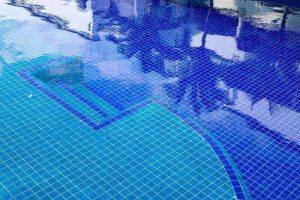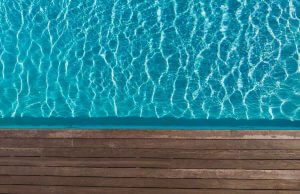A crisp, gleaming waterline is the signature look of any well-kept fiberglass pool. Yet suntan oil, pollen, dust, and evaporated minerals collect right where water meets air, leaving a dingy “bathtub ring” that spoils the view.
A fiberglass gel-coat is inherently slick and non-porous, so the cleaning process is quick—if you use the right tools and steer clear of harsh chemicals. Follow the step by step instructions on how to clean the waterline on a fiberglass pool below to avoid stains and keep that horizon-line sparkle while preserving your shell’s lifetime warranty (and your sanity).
Why Fiberglass Makes Waterline Care Easier
- Non-porous surface – Gel-coat blocks microscopic algae, so grime stays loose and wipes away with light pressure.
- UV-stable colour – Modern pigments resist fading, meaning gentle scrubbing won’t bleach the pool wall.
- No grout lines – One continuous surface means nowhere for scale to hide.
- Chemical savings – Because crud doesn’t embed, you can skip the heavy acid washes concrete pools need every few years.
Tools & Pool Cleaners You’ll Need
| Essential | Notes |
| White nylon pool brush or non-scratch scrub pad | Same grade used on boat hulls |
| Telescopic pole | For easy reach around the perimeter |
| Gel-based waterline cleaner | Enzymatic or mild citric-acid formulas cling and dissolve oils fast |
| Bucket of warm water | Rinses pads between passes. |
| Microfibre cloths | Final polish, no lint. |
| Vinyl or nitrile gloves | Protect hands from cleaners. |
| Optional melamine sponge | “Magic-Eraser” style, great for calcium scaling spots—test first. |
| Avoid: steel wool, pumice, stiff deck brushes, powdered cleansers, bleach gels | All can scratch or dull gel-coat. |
Step-by-Step Waterline Fiberglass Pool Cleaning Routine
- Lower the water ~5 cm.
Drop the level just below the scum line with a backwash or submersible pump. Exposing the band lets cleaner work undiluted. Never drain farther—water weight keeps a fiberglass surface shell properly seated. - Pre-rinse & soften.
Splash pool water onto the exposed strip to loosen body oils. If a pressure-side cleaner is running, turn it off so it doesn’t sling floating debris while you work. - Apply a gel-based cleaner.
Squeeze a palm-sized bead onto your pad and spread a thin coat over about a metre of wall. Citrus or enzyme gels cling better than liquids, breaking down suntan-oil rings without harsh chemicals and acids. - Gentle circular scrub.
Use light pressure and 10 cm circles. Let chemistry—rather than elbow grease—do most of the work. Spending too long in one spot can create uneven gloss. - Rinse & inspect.
Dunk the pad, squeeze it out, and splash clean water on the section. Run a fingertip across the gel-coat; it should feel glassy, not sticky. A faint line left? Re-apply and repeat with the same light touch. - Tackle scale spots.
White calcium bumps form where evaporation is highest. Dab a melamine sponge with diluted citric cleaner, press for 30 s, then wipe. Still stubborn? Crush two vitamin-C tablets with a splash of water into a paste, smear it on the nodule, wait five minutes, and wipe—no scratching required. - Microfibre polish.
Buff the cleaned band dry. This removes water streaks and restores a high gloss—especially noticeable on dark-blue shells. - Refill & re-balance chemistry.
Top up to mid-skimmer level. Test pH and alkalinity (cleaners can nudge both downward). Aim for pH 7.4–7.6 and TA 80–120 ppm, then run the pool pump an hour to disperse any residue.
Pro Fibreglass Pool Cleaning Tips from Okeanos Techs
There are a few smart habits that make a big difference. First, consider using a mesh skimmer net weekly. They’re inexpensive, and they capture a surprising amount of suntan oil, along with surface debris, before it circulates. Adding a weekly dose of pool enzymes helps too, breaking down oils before they can bond to the waterline.
If you’re using a solar blanket or pool cover, always rinse it off before rolling it up. Otherwise, you’re dumping pollen and debris right back onto your tiles. And if you’re ready to splurge a bit, a robotic pool vacuum with a waterline cleaning mode (think Maytronics M400+) can handle much of the scrubbing of your fiberglass pool floor for you. With one of those in rotation, manual cleanings drop to just once a month.
Common Mistakes Fiberglass Pool Owners Should Avoid
Some pool chemicals and cleaning tools just don’t belong anywhere near a fiberglass shell. Bleach-based bathroom gels are one culprit—their high pH dulls and pits gel-coat surfaces, and that’s exactly the kind of damage warranties won’t cover.
Pumice stones, while fine for plaster pools, gouge micro-trenches in fiberglass that algae love to settle into. Wire brushes? Even the “soft” ones made from stainless steel will leave hairline scratches that trap grime.
Another common error: draining the pool too far. Dropping the water level below the returns can make the shell float if there’s any rise in groundwater. Five centimetres is the safe limit.
And don’t overlook water chemistry, since having proper chemical balance can be a huge factor in the longevity of your pool and keeping your pool clean. High pH combined with high calcium levels accelerates scale buildup. In truth, good chemical balance is 80 percent of prevention.
How Often Should You Clean the Waterline on a Fiberglass Pool?
The ideal frequency depends on how the pool is used. For low-traffic pools with minimal tree cover, a thorough cleaning every three to four weeks during peak season is typically enough. But if your pool sees heavy family use—especially with sunscreen in the mix—a light weekly wipe will help remove floating debris before it builds up.
After any storm or heavy pollen drop, don’t wait. Clean the waterline of your pool surface the same day before that ring has a chance to bake on.
Each session takes only about 15 minutes on a standard 30-foot swimming pool. That’s a small price for avoiding the acid-wash headaches faced by concrete pool types.
Why This Gentle Method Pays Off
Taking a delicate, chemistry-first approach preserves your pool’s beauty and performance over time. A scratch-free gel-coat means chlorine works more efficiently—cutting your chemical use by up to 25 percent because algae have nowhere to cling. You also protect the high-gloss finish, which is especially prominent on white fiberglass pools, that enhances your backyard’s appeal and resale value. Even better, you stay safely within the manufacturer’s colour warranty, which doesn’t cover damage from abrasive cleaners.
Finally, decorative tiles and inlays last longer too. With no acid splashes, their integrity and shine are preserved season after season.
Get a Fiberglass Pool That Lasts with Okeanos Pools GTA
When a high-quality fiberglass pool is installed with care, it becomes more than a water feature. It’s a lasting structure designed to anchor family life and elevate a property for years. Choosing Okeanos for your fiberglass pool installation means investing in durability that doesn’t ask for constant attention.
Care is straightforward. A soft cleaning pad, a mild gel-based solution, and a few minutes of upkeep within a regular cleaning schedule are enough to protect the finish. And when questions arise, you’ll have direct access to our team. It’s as easy as picking up the phone—just contact us, and we’ll give you all the info you need to keep your pool in peak condition.
Fiberglass has become the preferred choice for Ontario homeowners for good reason. It holds its form, resists wear, and keeps its elegance long after other materials have begun to fade.





